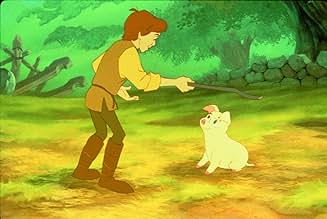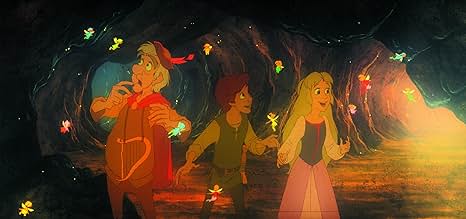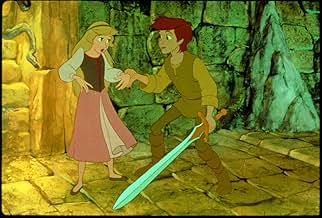ÉVALUATION IMDb
6,3/10
42 k
MA NOTE
Un jeune garçon et ses amis marginaux partent à l'aventure pour trouver un objet de magie noire à la puissance ultime avant un tyran diabolique.Un jeune garçon et ses amis marginaux partent à l'aventure pour trouver un objet de magie noire à la puissance ultime avant un tyran diabolique.Un jeune garçon et ses amis marginaux partent à l'aventure pour trouver un objet de magie noire à la puissance ultime avant un tyran diabolique.
Grant Bardsley
- Taran
- (voice)
Freddie Jones
- Dallben
- (voice)
Susan Sheridan
- Eilonwy
- (voice)
Nigel Hawthorne
- Fflewddur
- (voice)
Arthur Malet
- King Eidilleg
- (voice)
John Byner
- Gurgi
- (voice)
- …
Lindsay Rich
- Fairfolk
- (voice)
Brandon Call
- Fairfolk
- (voice)
Gregory Levinson
- Fairfolk
- (voice)
Eda Reiss Merin
- Orddu
- (voice)
Adele Malis-Morey
- Orwen
- (voice)
Billie Hayes
- Orgoch
- (voice)
Phil Fondacaro
- Creeper
- (voice)
- …
Peter Renaday
- Henchman
- (voice)
James Almanzar
- Henchman
- (voice)
Wayne Allwine
- Henchman
- (voice)
Steve Hale
- Henchman
- (voice)
Phil Nibbelink
- Henchman
- (voice)
Histoire
Le saviez-vous
- AnecdotesThe first Disney animated film that's not a musical, does not contain any songs neither performed by characters, nor in the background.
- GaffesTaran unchains the gate barring their escape from the castle. In subsequent shots, the lock and chains reappear and then, finally disappear.
- Générique farfeluThere are no opening or cast and crew credits.
- Autres versionsThe version of the film released to theaters omits numerous fully animated scenes that include shots of graphic violence as Taran fights his way out of the castle and shots of Eilonwy sporting ripped garments as she's hanging for her life with Taran and Fflewddur. The most well-known deleted scene, due to a clumsy jump that it left in the film's soundtrack and a cel of the infamous scene appearing online, is that of a man being mauled by one of the Cauldron-born.
- ConnexionsEdited from Fantasia (1940)
Commentaire en vedette
"The Black Cauldron" provides us with "Exhibit A" of the disorganized nature of the Disney organization from the mid-1970s through the mid-80s. The company's feature films were attracting smaller and smaller audiences, and no real creative force had emerged since Walt Disney's death in 1966. By the mid- to late-70s, it was clear that new ideas needed to be tried. The phenomenal success of "Star Wars" appeared to offer a sure-fire way to box-office success: sci-fi/fantasy movies. At the same time, Disney Studio's full-length animated features continued their descent from the heights scaled in 1959's "Sleeping Beauty", at first downscaling the subject matter, then progressing to less and less impressive animation, and finally combining the first two trends with boring storytelling (see "The Fox and the Hound" - 1981).
It was in this context that pre-production began on "The Black Cauldron" in the late 1970s. From an artistic standpoint, its goals were two-fold. First, the film was to recapture the lead in animation quality that Disney had traditionally held, while the second goal was to incorporate the advances in animation and subject matter made in the 1970s (i.e., playing "catch up"). Some early decisions were good: the source material was top-notch. Lloyd Alexander's "Chronicles of Prydain" are fantastic works of fantasy for the young adult - I loved them as a middle-schooler in the mid-80s, and the choice to film the story in 70mm widescreen harkened back to the glory days of "Sleeping Beauty." Unfortunately, not much else worked. The studio's writers did a terrible job of condensing the first two books of Alexander's series, and we end up caring little for the characters that emerge, or for the plot as it unfolds. Also, the movie's tone is uneven. Overall, the work is very dark and un-Disney, which would've been fine had it been executed better. Further, the grimness of the plot doesn't mesh with occasionally clumsy and earthy attempts at humor, and the character animation fluctuates between sober naturalism and exaggerated, cartoonish mannerisms (stretching ears, gaping mouths, etc.) Still, some of the shots are stunning and rank among the best in the history of hand-drawn animation (e.g., multiplaned exterior shot of the Horned King's castle, beautiful backgrounds within the same, Hen-Wen's capture by the Horned King's creatures). The result of this mish-mash was a box-office flop ($25 million to make, $5 million in ticket sales upon its 1985 release).
In short, see this film for its often-impressive animation and intermittent charm. Be sure to get the newly-available widescreen version on DVD. Bemoan the end of the era of stunning hand-drawn animation (Disney has closed up its shop; "Home on the Range" was its penultimate hand-drawn feature). Don't expect a classic, but appreciate the vision of its artistry - even if the final product didn't quite mesh satisfactorily. "The Black Cauldron" is a noble failure.
It was in this context that pre-production began on "The Black Cauldron" in the late 1970s. From an artistic standpoint, its goals were two-fold. First, the film was to recapture the lead in animation quality that Disney had traditionally held, while the second goal was to incorporate the advances in animation and subject matter made in the 1970s (i.e., playing "catch up"). Some early decisions were good: the source material was top-notch. Lloyd Alexander's "Chronicles of Prydain" are fantastic works of fantasy for the young adult - I loved them as a middle-schooler in the mid-80s, and the choice to film the story in 70mm widescreen harkened back to the glory days of "Sleeping Beauty." Unfortunately, not much else worked. The studio's writers did a terrible job of condensing the first two books of Alexander's series, and we end up caring little for the characters that emerge, or for the plot as it unfolds. Also, the movie's tone is uneven. Overall, the work is very dark and un-Disney, which would've been fine had it been executed better. Further, the grimness of the plot doesn't mesh with occasionally clumsy and earthy attempts at humor, and the character animation fluctuates between sober naturalism and exaggerated, cartoonish mannerisms (stretching ears, gaping mouths, etc.) Still, some of the shots are stunning and rank among the best in the history of hand-drawn animation (e.g., multiplaned exterior shot of the Horned King's castle, beautiful backgrounds within the same, Hen-Wen's capture by the Horned King's creatures). The result of this mish-mash was a box-office flop ($25 million to make, $5 million in ticket sales upon its 1985 release).
In short, see this film for its often-impressive animation and intermittent charm. Be sure to get the newly-available widescreen version on DVD. Bemoan the end of the era of stunning hand-drawn animation (Disney has closed up its shop; "Home on the Range" was its penultimate hand-drawn feature). Don't expect a classic, but appreciate the vision of its artistry - even if the final product didn't quite mesh satisfactorily. "The Black Cauldron" is a noble failure.
- beatlesguru1
- 25 mars 2006
- Lien permanent
Meilleurs choix
Connectez-vous pour évaluer et surveiller les recommandations personnalisées
Détails
- Date de sortie
- Pays d’origine
- Site officiel
- Langues
- Aussi connu sous le nom de
- Le Chaudron noir
- Lieux de tournage
- sociétés de production
- Consultez plus de crédits d'entreprise sur IMDbPro
Box-office
- Budget
- 44 000 000 $ US (estimation)
- Brut – États-Unis et Canada
- 21 288 692 $ US
- Fin de semaine d'ouverture – États-Unis et Canada
- 4 180 110 $ US
- 28 juill. 1985
- Brut – à l'échelle mondiale
- 21 289 084 $ US
- Durée1 heure 20 minutes
- Couleur
Contribuer à cette page
Suggérer une modification ou ajouter du contenu manquant

Lacune principale
What is the Japanese language plot outline for Taram et le Chaudron magique (1985)?
Répondre






























